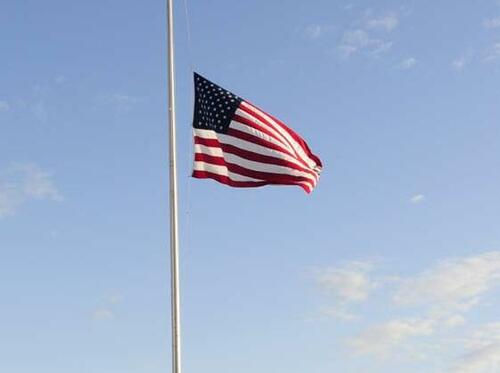Authored by David Lapp-Jost via RealClear Wire,
The novel River City One tells a personal tale of a soldier long returned home, but permanently adrift. Partly the experiences of a man carrying the heavy weight of many white Middle American challenges, the story’s theme of brokenness coming from war is never too far in the background. Defying expectations, tropes, and stereotypes, River City One’s story is compelling and powerful.
A novel like this must be readable, well-paced, and strike appropriate notes of plausibility and authenticity. River City One absolutely delivers as a modern American veteran’s story. The characters feel right. Their motivations, values, foibles, jobs, and dispositions command interest and draw the reader into the book’s community while at the same time not at all seeming exaggerated or caricatured. At welcome intervals, bleak-but-enjoyable segments bring a dry, fun humor to the text, usually relating to the narrator’s tragicomic job at a law practice.
Significant stretches of the narrative reflect aspects of the white Middle American experience. White men are seen as the most privileged in our society, rightfully, but communities like the protagonist John Walker’s carry terrible burdens. Many characters have largely meaningless “Bullshit Jobs,” to cite a defining sociological book of our time, jobs that neither serve nor fulfill. Long dead is Bush-era religiosity; this is an era of secular disillusionment. The characters are driven by the harsh demands of money and work, and some are deeply lonely. People lack community and are unhealthy. While the opioid epidemic does not really make an appearance, drugs and sickness are present and a minor character lost a girl decades ago to a car accident – a painful recounting of a sort of catastrophe that claims 1 percent of American lives and hollows out people and communities, much as killing does. John is an insightful observer of brokenness, and honest about crises that others dismiss or ignore.
The driving focus of the text is relationships and the lack thereof, and the story starkly depicts the white male experience of loneliness, told through an ex-military lens. Men in general are lonely in the U.S., often having few friends, often relying heavily on one marital partnership that these days has a 50 percent chance of failure. Middle-aged white men commit suicide at about twice the national average rate (with veterans spearheading the trend at a rate that eclipses our losses in war). Some simply “die of loneliness” – an epidemic of health issues related to isolation that are not widely or well understood. And of course, war adds another element. Twenty years ago, conservative-leaning, white middle class Americans (as well as African Americans from the South) signed up in droves to go fight in Afghanistan and Iraq. These ex-soldiers face a heightened crisis of health and human relationship, as we see in John Walker’s circle of military connections, who seem to all have relationship problems. With its strong and effective focus on relationships, River City One humanizes and compassionately depicts a hurting veteran.
In John’s life, we witness a deep loneliness, aimlessness, and a lack of friendship aside from an old war buddy and faintly sociopathic colleagues. “Friends don’t appear out of nowhere,” says Grace, John’s wife. “They develop over time – like, a long time, a lot longer than one week.” She intuitively understands the lack of human connection that drags John down. This crisis of relationship is seriously hurting our overworked, under-vacationed, “Bowling Alone” nation today, to name another relevant book. Sadly, Grace has faded away as an influence on John, and like so many men and especially men in masculine-coded sectors like the military, John doesn’t seem to have much connection with women as friends, or to have relationships with people who show him care and love.
The legacy of war is a deep and powerful undercurrent of the text… and is also elusive. John’s acquaintances wonder what it was like to kill an Iraqi or Afghan (the settings – past and present, in war or in peace – are ambiguous) or how it was to lose a comrade. John does not offer a fixed answer or take a uniform approach to the question, and he actually doesn’t have a fixed answer. Our defining memories of trauma change over time, like our national memory of 9/11 or a child’s experience of losing a parent. Like insensitive acquaintances who ask John about killing and dying, we readers are partly-unwelcome interlocutors in John’s life, witnesses of a painful inner journey, not people entitled to a juicy story. Soldiers and veterans aren’t there to fulfill our fantasies or show us deep truths about honor or heroism. Their way is hard for anyone committed to holding onto goodness, and their job is not part of the purpose we humans are for. John teaches his son to pray for souls in purgatory even though he says “doesn’t know what that means.” Perhaps he does know, more than most.
The author’s role in telling this story is a contribution to the world. But we as a society must consider the consequences of war not just for the soldier, but for the people he or she is supposed to be protecting, at home and (in theory) abroad. The perhaps $8 trillion that the United States expended on the War on Terror caused maybe a million to four-and-a-half million deaths – almost all poor people in Muslim countries – and shattered many communities, many families, many dreams. The war disillusioned millions of Americans and billions of people in the Global South.
And the cost of the war precluded building the society that John needs and longs for, one that is beautiful, healthy, and rich in relationships and free time for its residents. Let us imagine John comes from an economically average U.S. city of 500,000. Its proportional financial share in the War on Terror was over $12 billion. Especially considering that investing in human capital and healthy development yields exponential returns, those $12 billion are a huge loss. They could have addressed drug dependence, mental health, urban beautification, safe and sustainable transit. Instead, the resources went to failed wars. As veterans like the author intuitively know, we as a country misused our resources. Money, yes, and even more than that, the youth and strength of young men and women who could have served in other ways.
Those who have borne burdens for their service to our country don’t just deserve care, love, healing, and resources. As we offer support to those who have been harmed in body, mind, or soul, let us also learn from the caution of so many veterans. Do not repeat the mistakes of the past. Do not send more young people to be broken in expeditionary wars of choice. The failures of the administrations – all administrations – of the last decades must not be repeated. In the end, in this life, it is not the decision-makers who pay the price.
David Lapp-Jost (M.Ed.) is a Friedensarbeiter (Peace Worker) with the German Mennonite Peace Committee, which since World War II has worked for peace in Europe.
Loading…
This post was originally published on this site
The post Decisionmakers Never Pay The Price appeared first on Nemos News Network.
Related posts:
Views: 0
 RSS Feed
RSS Feed

















 November 8th, 2023
November 8th, 2023  Awake Goy
Awake Goy 





 Posted in
Posted in  Tags:
Tags: 
















